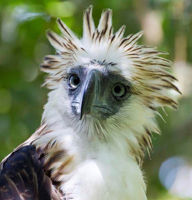
Philippine eagle 288
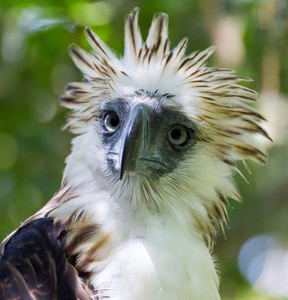
Photo by Kike Arnal
Found only in the Philippines, the Philippine eagle has a distinctive headdress and piercing eyes.
There's a videographer named Neil Rettig whose work you've probably seen in nature documentaries without knowing it. He takes you so deep into the world of animals that you forget about cameras and people. He's been a heavy contributor to the world of wildlife cinematography for going on five decades. His work has been featured on many networks, but unless you read the credits, you might have missed his name.
Such is the case with me. I learned of Neil after I was consulted about a sick harpy eagle being seen a few years back by colleagues at the University of Wisconsin School of Veterinary Medicine. I had to see this unusual bird. As it turned out, the eagle was one of Neil's birds, and I was soon in contact with Neil's wife, Laura Johnson. She welcomed my husband, Colin, and me out to their farm in western Wisconsin. We had a lovely visit, getting to see the magnificent bird up close, as well as their many other trained birds of prey. Laura also is a veterinarian and works with local wild birds so we were able to talk shop and trade notes.
Neil was off in the Philippines finishing his latest movie, Bird of Prey. Laura showed us a trailer of the movie. Thus began my deep interest in the stunning Philippine eagle.
Wingspan 288
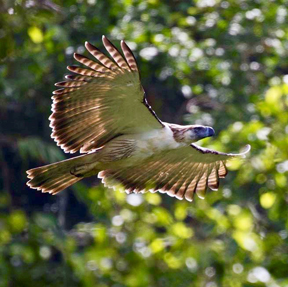
Photo by Kike Arnal
One of the largest forest raptors in the world, the Philippine eagle has a wingspan of seven feet.
Found only on the islands of the Philippines, the country's namesake bird is the largest eagle in the world, with a wingspan of seven feet, a distinctive headdress of feathers, arresting blue-gray eyes and powerful talons. Solitary and territorial, each breeding pair requires 10,000 to 27,000 acres of forestland to feed and reproduce. Forest destruction and fragmentation imperil their existence.
If you've ever seen old film footage of Philippine eagles, it probably was shot by Neil in the late 1970s and early '80s. He was the first, and so far only, person to ever capture details of their nest life. The rarity of these images is due, first, to the rarity of the eagles. It's estimated that there may be as few as 200 left in the wild today, and each pair produces a single egg only every two years. Second, it's extremely difficult to film them, particularly if you are trying your best not to disrupt them. Even this most recent film, using the latest camera technology, improved biological data on the eagles, and the assistance of local conservation groups, took years of careful work to complete. Completing the documentary came down to sheer determination — a passion to share this charismatic bird with the world. The passion grew from a need to tap into a societal environmental consciousness to turn things around before these amazing birds disappear forever.
Scott Ford and Valkyrie 288
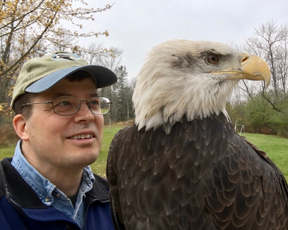
Photo by Dr. Scott Ford
Dr. Scott Ford, an avian medicine specialist, is shown with a former patient, Valkyrie.
All around the world, birds are in trouble. Bird Life International reported in 2018 State of the World's Birds that 40% of the world's birds are in decline. This fall, the journal Science published a report on the decline of birds across North America. The researchers found that in the past half-century, not only rare and threatened species but those considered common also have diminished, amounting to a net loss of some 3 billion birds.
It's easy to feel overwhelmed to the point of apathy and tune out yet another page of bad news. But Neil's film about the Philippine eagle makes it personal and hard to turn away. I found the trailer alone moving and hopeful, inspiring me to act on behalf of this beautiful bird.
I didn't have to wait long to discover my most useful means of contribution. Laura contacted me a couple of weeks after we first met and put me in touch with the Philippine Eagle Foundation, a Philippines-based group run by locals that has been working since the 1980s to conserve the rare bird. Their approach includes educating the public, advocating politically for the eagles and their ecosystem, treating injured birds and breeding them in captivity. I was consulted regarding several medical cases.
One in particular stands out for reasons you will see later. The bird had been injured by gunshot, a startlingly common problem despite the fact that the birds pose little danger to humans or livestock. (They dine on various medium-sized mammals in the forest, most famously, small monkeys.) I reviewed X-ray images and provided my input for medical care. I do a lot of online consulting for veterinarians around the world, and it feels good to share my experience to help birds in far-flung places. It felt particularly amazing in this case, since there are so few of these birds left.
Release 288
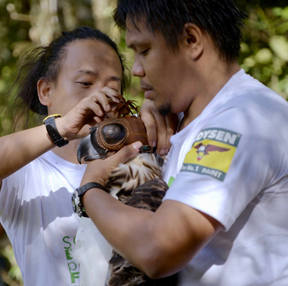
Photo from birdofpreymovie.com
After healing from gunshot wounds, Matatag is prepared for release to the wild.
Two years later, I was pleased to learn that the film had been completed. It would be another couple of years before the movie was released on Amazon (which happened this May) and I was able to watch the whole thing. Yeah, being the bird sap that I am, I pretty much cried through the whole movie.
The film starts by telling the story of Neil's passion, beginning in the 1970s, to share Philippine eagles with the world. Then we're taken to present day to show that same spark in the eye of the same man, decades later, preparing to film the birds again. We follow the trials of finding a nest, braving the rigors of rainforested mountains and getting close enough to film the birds.
We follow the lives of two pairs of Philippine eagles from two different decades, building their nests and raising their chicks. As the scenes flip back and forth between the 1970s and the 2010s, you see the same story unfolding: a man struggling to tell the story of devoted eagle parents doing the same things they've done for millions of years in a world that, unbeknownst to them, is rapidly closing around them. Both man and bird are up against time pressures and monumental difficulties but they only see forward. There's no pause to get depressed or give up, despite heartbreaking setbacks. They keep going against the odds.
The end of the film brings a moment that I will never forget. Sorry, this is a mild spoiler, but it's important to tell this story. Toward the end, the eagle I was consulted about, named Matatag, is shown being cared for. I sometimes hear back from the myriads of doctors who consult with me but I almost never see images of the patients afterward. But in the film, there's that beautiful bird, its massive brown wings and flared mop of head feathers, wildness flashing in its stunning sapphire eyes. Personnel from the Philippine Eagle Foundation catch it from its care enclosure, put a hood over its head to keep it calm, then take it on a long trip up into the mountain forest in the arms of a caretaker.
At the rim of a forested canyon, the hood is removed. The bird launches into space, flapping over massive, sun-splashed trees.
My heart soared like the freed eagle: There is hope. We all have a part to play.
My contribution was simple — I sat in my cushy office and handed out advice via the internet. But that modest contribution made a difference. It's easy to become apathetic in our daily lives as we are barraged by news of the deteriorating condition of our planet and the failure of our leaders to act. And there are so many species in trouble, it can be hard to decide where to invest your time and resources.
But don't forget that only 40 years ago, bald eagles, California condors, and peregrine falcons balanced on the edge of oblivion. Their comebacks came about not just because scientists did the work of conservation. Thousands of concerned citizen-volunteers in grassroots organization all over the U.S. helped, starting with donated nickels and dimes, plans scribbled on napkins and projects conducted in back yards.
Habitat recovery on the scale needed for the Philippine eagle will take a long, long time. Their slow reproductive cycle means slow population growth. And there are many serious socioeconomic challenges to navigate in the country. So the problem is more complex and will take longer to resolve than the species conservation efforts I mentioned above. But we cannot lose hope. We can save the Philippine eagle.
About the author: Dr. Scott Ford owns Avian Veterinary Specialty Services, providing avian veterinary consultation and surgical services, primarily for wildlife projects, throughout North America. He is an avian consultant for the Veterinary Information Network. Ford became interested in birds as a teenager and worked in raptor centers in Alaska and Washington to earn experience for veterinary school. He graduated with his DVM from Washington State University in 1998. In 2006, he achieved board certification in avian medicine and surgery within the American Board of Veterinary Practitioners. Ford has practiced in Washington, California and Alaska, and now lives with his husband in Milwaukee, Wisconsin. His practice is restricted solely to avian patients, primarily wildlife; he sees pet birds part-time when not on fieldwork assignments.